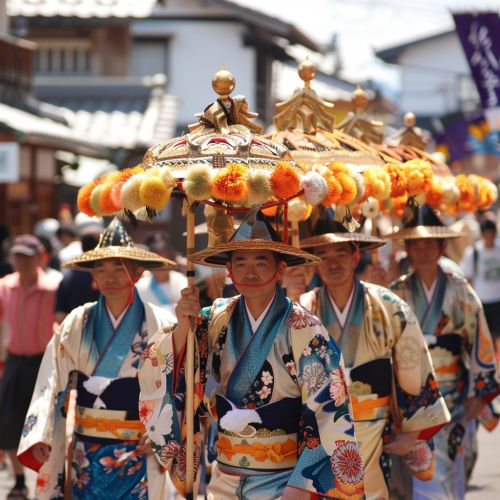Japanese Festivals
Overview
Japanese festivals, known as matsuri (祭り), are an integral part of Japanese culture, reflecting the country's rich history, religious beliefs, and seasonal changes. These festivals are celebrated throughout the year and vary significantly from region to region. They often involve elaborate rituals, traditional music, dance, and food, and are deeply rooted in Shinto and Buddhist traditions.
Historical Background
Japanese festivals have ancient origins, with many tracing back to the early periods of Japanese history. The Heian period (794-1185) saw the formalization of many festivals, which were often linked to agricultural cycles and the worship of deities. Over time, these festivals evolved, incorporating elements from various cultural influences, including Chinese and Korean traditions.
Types of Festivals
Japanese festivals can be broadly categorized into several types, each with its unique characteristics and significance.
Shinto Festivals
Shinto festivals, or Shinto matsuri, are dedicated to the kami (deities) of the Shinto religion. These festivals often involve processions, offerings, and purification rituals. Examples include:
- **Gion Matsuri**: Held in Kyoto, this festival dates back to the 9th century and is dedicated to the Yasaka Shrine. It features elaborate floats, traditional music, and dance.
- **Kanda Matsuri**: Celebrated in Tokyo, this festival honors the Kanda Myojin Shrine and includes parades, mikoshi (portable shrines), and various performances.
Buddhist Festivals
Buddhist festivals, or Buddhist matsuri, often commemorate significant events in the life of the Buddha or honor Buddhist deities. Key examples include:
- **Obon**: A festival to honor deceased ancestors, involving rituals such as the Bon Odori dance and the lighting of lanterns.
- **Hana Matsuri**: Celebrated on April 8th, this festival marks the birth of the Buddha and includes flower offerings and parades.
Seasonal Festivals
Seasonal festivals celebrate the changing seasons and agricultural cycles. Notable examples include:
- **Hanami**: The cherry blossom viewing festival, where people gather to appreciate the blooming sakura trees.
- **Tanabata**: Also known as the Star Festival, it celebrates the meeting of the deities Orihime and Hikoboshi and involves decorating bamboo branches with colorful paper strips.
Regional Variations
Japanese festivals vary significantly across different regions, reflecting local customs, history, and geography.
Tohoku Region
The Tohoku region is known for its vibrant and energetic festivals, such as:
- **Nebuta Matsuri**: Held in Aomori, this festival features large illuminated floats depicting warriors and mythical creatures.
- **Kanto Matsuri**: Celebrated in Akita, it involves balancing long bamboo poles with lanterns, showcasing the skill and strength of the participants.
Kansai Region
The Kansai region, home to cities like Kyoto and Osaka, hosts some of Japan's most famous festivals:
- **Awa Odori**: A dance festival in Tokushima, where participants perform traditional dances in colorful costumes.
- **Tenjin Matsuri**: One of Osaka's major festivals, featuring boat processions and fireworks.


Rituals and Practices
Japanese festivals are characterized by a variety of rituals and practices, many of which are deeply symbolic.
Mikoshi Processions
A mikoshi is a portable shrine that houses the spirit of a deity. During festivals, these shrines are carried through the streets in elaborate processions, accompanied by chanting and music. The act of carrying the mikoshi is believed to purify the area and bring blessings to the community.
Traditional Music and Dance
Music and dance are integral to Japanese festivals. Traditional instruments such as the taiko drum, shamisen, and flute are commonly used. Dance performances, such as the Bon Odori during Obon, are often participatory, inviting festival-goers to join in.
Food and Drink
Festival food, or matsuri yatai, is a highlight of Japanese festivals. Stalls offer a variety of traditional snacks and dishes, such as takoyaki (octopus balls), yakisoba (fried noodles), and taiyaki (fish-shaped cakes). Sake and other beverages are also commonly enjoyed.
Modern Adaptations
While traditional elements remain central to Japanese festivals, modern adaptations have emerged, reflecting contemporary culture and global influences.
Fusion Festivals
Some festivals have incorporated elements from other cultures, creating unique fusion events. For example, the Yosakoi Festival combines traditional Japanese dance with modern music and choreography, attracting participants from around the world.
Technological Innovations
Technology has also influenced Japanese festivals. Light shows, digital projections, and social media have become integral to the festival experience, enhancing the visual spectacle and broadening the reach of these events.
Cultural Significance
Japanese festivals play a crucial role in preserving cultural heritage and fostering community spirit. They provide an opportunity for people to connect with their history, express their religious beliefs, and celebrate the changing seasons. Festivals also serve as a platform for artistic expression, showcasing traditional crafts, music, and dance.
Challenges and Preservation
Despite their cultural significance, Japanese festivals face challenges, including urbanization, demographic changes, and the impact of globalization. Efforts to preserve these traditions include government support, community initiatives, and the involvement of younger generations in festival planning and participation.
